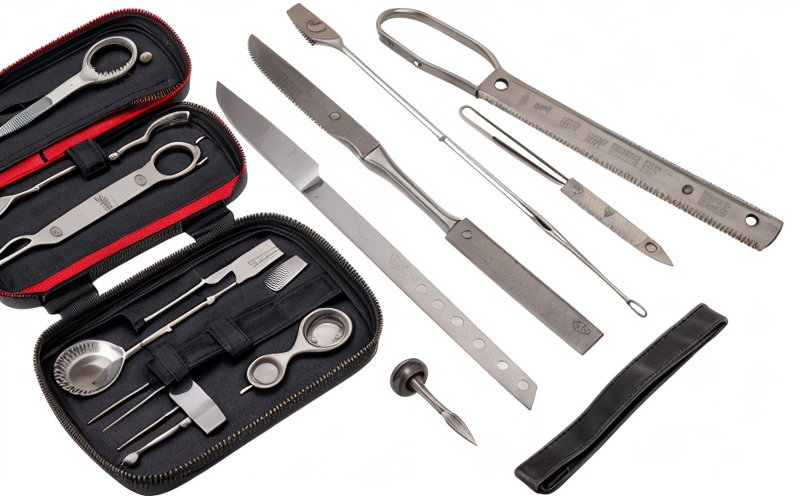ISO 7741 Needle Holder Jaw Strength Testing
The ISO 7741 standard is specifically designed to assess the mechanical integrity of needle holder jaws used in surgical instruments. These jaws are crucial components that must withstand significant loads during surgical procedures, ensuring patient safety and optimal tool performance. This testing ensures that needles can be securely held within the jaw without compromising the stability or functionality of the instrument.
The test procedure outlined in ISO 7741 involves subjecting the needle holder to a specified load, typically applied gradually until the specimen fails or reaches predetermined criteria for strength and stability. The apparatus used must meet strict requirements to ensure accurate results, including a hydraulic press capable of applying controlled loads with precision.
The standard specifies that the jaw should be loaded at a rate of 0.5 MPa/s ± 20%, ensuring consistent testing conditions across different devices. This standardized approach helps manufacturers and quality assurance teams achieve reliable outcomes for compliance purposes. The test is critical not only for regulatory approval but also to ensure product reliability in real-world surgical scenarios.
The importance of this testing extends beyond mere compliance; it plays a vital role in enhancing patient safety by ensuring that medical devices perform as intended under stress. By adhering to ISO 7741, manufacturers can demonstrate their commitment to quality and safety, thereby building trust with healthcare professionals and patients alike.
Understanding the nuances of this testing process is essential for anyone involved in developing or auditing surgical instruments. Compliance officers will find it particularly relevant when ensuring that products meet international standards, while R&D engineers benefit from precise knowledge about how different materials and designs affect performance under load. For quality managers, this information supports robust quality assurance programs by identifying potential issues early in the product lifecycle.
Accurate testing according to ISO 7741 is crucial for ensuring that needle holder jaws can withstand the rigors of surgical use without failing. This standard provides a clear framework for manufacturers and laboratories alike, allowing them to produce reliable medical devices that meet both regulatory requirements and performance expectations.
- Compliance with International Standards: Ensures that products meet global regulatory standards.
- Enhanced Product Reliability: Reduces the risk of device failures during critical procedures.
- Patient Safety: Guarantees that surgical instruments perform as intended, minimizing risks to patients.
- Consistent Results: Standardized testing ensures uniform quality across different batches and production runs.
Applied Standards
The ISO 7741 standard is widely recognized for its role in assessing the mechanical integrity of needle holder jaws. It provides a comprehensive framework that covers all aspects of testing, from specimen preparation to data interpretation. The standard specifies precise methods and criteria to ensure accurate results, making it an invaluable tool for manufacturers, laboratories, and regulatory bodies.
The application of ISO 7741 is not limited to just one type of surgical instrument; rather, it applies broadly across various categories of medical devices that utilize needle holder jaws. This includes instruments used in orthopedic surgery, neurosurgery, urology, and many other specialties where precision and strength are critical.
In addition to the core testing procedure described in ISO 7741, there may be additional requirements depending on the specific application of the device. For instance, certain devices might require further evaluation beyond basic jaw strength testing due to their unique design or intended use. Laboratories conducting these tests should consult relevant guidelines and supplementary standards as necessary.
The standard also emphasizes the importance of maintaining accurate records throughout the testing process. This includes documenting all test parameters, including load rates, temperatures, and any other conditions that could affect results. Proper record-keeping ensures traceability and reproducibility, which are crucial for compliance with regulatory requirements and quality assurance practices.
By adhering to ISO 7741, manufacturers can demonstrate their commitment to producing high-quality medical devices that meet the highest standards of safety and efficacy. This not only supports ongoing product improvement but also builds confidence among healthcare providers who rely on these tools during critical procedures.
Use Cases and Application Examples
The application of ISO 7741 Needle Holder Jaw Strength Testing is extensive within the medical device industry. This testing ensures that surgical instruments meet stringent performance requirements, particularly in critical procedures where precision and reliability are paramount.
In orthopedic surgery, for instance, devices like bone tongs often incorporate needle holder jaws to secure needles during internal fixation. The strength and stability of these jaws directly impact the success of the procedure by ensuring that the device remains securely attached throughout the operation. Failure of such a component could result in complications or even reoperation.
In neurosurgery, where delicate manipulation is required, devices with needle holder jaws are used to perform minimally invasive procedures. The strength and integrity of these jaws play a crucial role in ensuring that needles remain properly positioned during complex operations. Any compromise in the jaw's performance could lead to misalignment or loss of precision.
For urological instruments, needle holder jaws often facilitate the insertion of catheters into delicate tissues. Proper strength and stability are critical here as well, as any failure can result in tissue damage or infection. ISO 7741 testing ensures that these devices meet the necessary criteria for safe and effective use.
Beyond orthopedics, neurosurgery, and urology, needle holder jaws are integral to many other surgical specialties where precision is essential. By adhering to ISO 7741, manufacturers can ensure that their products consistently meet the highest standards of safety and performance across all applications.





